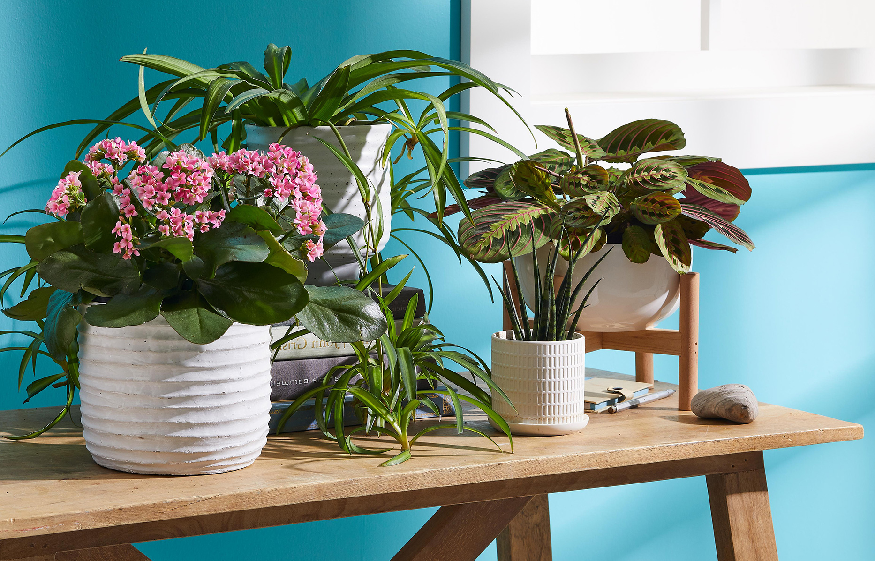
How to fight against winter grayness to feel good at home? Bring light and touches of color with our selection of 6 wonders: phalaenopsis, Christmas cactus, amaryllis, indoor azalea, poinsettia and kalanchoe. Go for a trip to your garden center or your florist! Let yourself be tempted by these winter splendors with abundant blooms that will embellish your interior.
PHALAENOPSIS, MAGNIFICENT MOTH ORCHID
Among the orchids here is the most cultivated that we gladly offer because appreciated for its ease of cultivation . In bloom almost all year round, it is in winter that we appreciate its charm more during long days of cocooning, in the warmth. Its long flower stalks highlight magnificent butterfly-shaped flowers . Orange, pink, white, mauve… there’s something for all tastes and interior styles!
Place it near a window with a sheer curtain to avoid direct sunlight. A room with temperatures between 18 and 22°C is perfect for him. Avoid near a radiator or fireplace. Once a week, prefer to bathe the pot in a saucer of water filled with non-calcareous water at room temperature than to bring water to the surface. If the air is dry, you can spray water on the foliage, in addition. Fertilizer is not required to support flowering. Collect the faded flowers then cut, with a tool with a sharp, clean blade, the floral stem above a node (swollen part). If a stem dries up, cut it back to encourage new growth. All summer, the phalaenopsis can bring a touch of exoticism and charm to your exterior, taking care to expose it in a shady place. Do not panic if your orchid has aerial roots that escape from the pot, it is a sign of good health. Repotting should be considered if the plant is cramped in the pot and if the space for the substrate is limited.
AMARYLLIS, SPECTACULAR FLOWERS
What a grace for this bulbous plant that brings color to your interior from autumn until spring . Placed near a light source, the amaryllis ( Hippeastrum ) develops one or more long stems topped with an imposing floral stem with 2 to 6 single or double Alone or accompanied, the imposing size bulb is easy to maintain.
Plant the bulb in a pot of soil or in a vase filled with water, to bathe only the roots, from October to take advantage of its exceptional flowering for the end of year celebrations. Make sure the bulb is only 2/3 buried. You can also buy it already forced, ready to flower. Water moderately, allowing the soil to dry out between two waterings. Place the jar in a room maintained between 18 and 21°C.
. Extend regular watering and add special flower plant fertilizer every 2 weeks. The bulb will thus replenish its reserves and see its foliage turn yellow over the months. During its rest period, reduce watering and place the bulb in a cool place (between 10 and 15°C), a room or outside exposed to the north, for a few months before it resumes its cycle of vegetation to bloom again. again, around mid-September. Stop the fertilizer inputs, continue the moderate water inputs and repot it if necessary. .
CHRISTMAS CACTUS, ABUNDANT FLOWERING
Fall for this succulent with very jagged foliage, with delicate flowers placed at the ends that bloom from November to February, or even March . Also called schlumbergera , it is covered with flowers in light or dark pink, orange or red hues . Yellow and white are more rare. Beautify your interior by growing several varieties to play with different tones.
If the air is dry due to heating, spray the foliage with non-calcareous water at room temperature. Reduce watering to twice a month when it is covered with flowers. There is no particular pruning to give it to keep it healthy for many years.
POINSETTIA, THE STAR OF CHRISTMAS
Also called Christmas Star ( Euphorbia pulcherrima ), this houseplant only blooms in fall and winter. The central flowers are insignificant.
Place the poinsettia in a lighted and airy room, away from drafts with a temperature between 18 and 22°C. Watch out for the heating, which will displease him! To stimulate flowering, you can add a diluted liquid fertilizer during a monthly watering session. Once the colorful bloom is over, water only once a month and cut off the bare stems. It will thus enter a vegetative period. New beginnings will develop and your poinsettia will bloom again. Do not hesitate to place it in your entrance to welcome your guests, decorate your festive table or color a corner of your kitchen.







